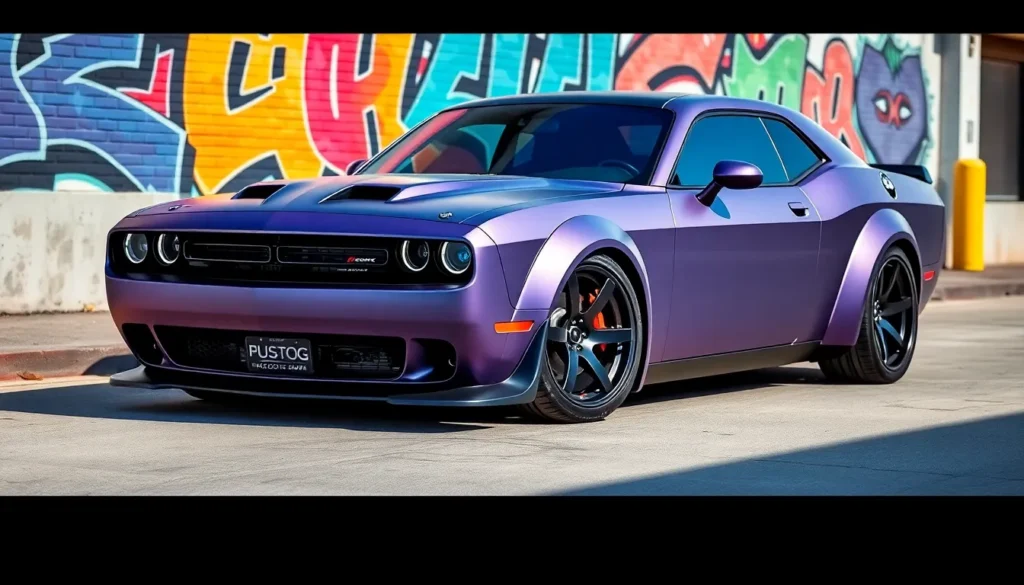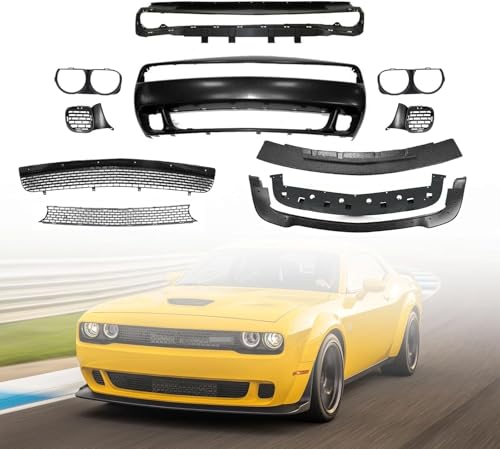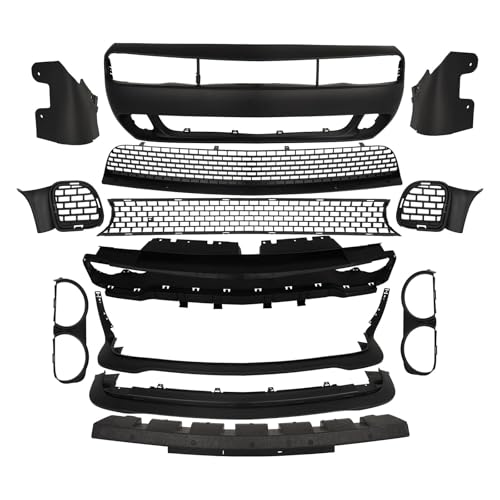When we think of American muscle cars that command respect on the road the Dodge Challenger immediately roars to mind. This iconic beast has been turning heads since its debut and today’s custom scene has transformed these powerful machines into truly one-of-a-kind masterpieces.
We’ve witnessed an incredible surge in Dodge Challenger custom builds that push the boundaries of automotive artistry. From aggressive wide-body kits and custom paint schemes to performance upgrades that’ll make your heart race these modified Challengers represent the perfect fusion of classic muscle car DNA and modern innovation.
Whether you’re dreaming of a subtle aesthetic enhancement or planning a complete ground-up transformation we’ll guide you through the most popular customization options available. Get ready to discover how to make your Challenger stand out from the crowd while maintaining that unmistakable muscle car heritage that makes these vehicles so special.
Custom Dodge Challenger Engine Modifications for Maximum Performance
Transforming your Challenger’s powerplant delivers the ultimate expression of American muscle performance. We’ve compiled the most effective engine modifications that’ll push your ride beyond factory limitations.
Supercharger and Turbocharger Upgrades
Supercharger installations provide immediate power gains with instant throttle response. ProCharger centrifugal superchargers deliver 150-200 additional horsepower to naturally aspirated V8 engines, while Whipple twin-screw units generate even more torque across the entire RPM range. We recommend Hellcat-style supercharger conversions for R/T models, which can push output beyond 700 horsepower when paired with supporting modifications.
Turbocharger systems offer exceptional efficiency gains for both V6 and V8 applications. Single turbo setups typically produce 100-150 horsepower increases on stock engines, while twin-turbo configurations can exceed 300 horsepower gains. Garrett Motion and Precision Turbo units provide reliable performance with proper tuning and fuel system upgrades.
Installation considerations require upgraded internals for forced induction applications. Forged pistons, connecting rods, and crankshafts become essential when targeting power levels above 600 horsepower. We’ve seen stock blocks handle moderate boost levels, but serious builds demand complete bottom end reinforcement.
Cold Air Intake and Exhaust System Enhancements
Cold air intake systems increase airflow efficiency while delivering aggressive engine sounds. K&N, Airaid, and Mopar Performance intakes typically add 10-20 horsepower while improving throttle response. We prefer enclosed airbox designs that prevent heat soak during extended driving sessions.
Cat-back exhaust upgrades free up important power through reduced backpressure. Borla ATAK, Corsa Extreme, and American Racing Headers systems deliver 15-25 horsepower gains while creating that unmistakable muscle car rumble. Active exhaust systems allow switching between quiet and aggressive modes for daily driving versatility.
Header installations provide the most substantial exhaust improvements for serious builds. Long tube headers combined with high flow catalytic converters can unlock 40-60 horsepower on naturally aspirated engines. We recommend ceramic coating to reduce under hood temperatures and prevent heat related issues.
ECU Tuning and Performance Chips
Professional ECU tuning maximizes every modification’s potential through precise calibration adjustments. Companies like DiabloSport, SCT Performance, and HP Tuners offer custom tuning answers that optimize fuel maps, timing curves, and transmission parameters. We’ve documented power increases of 50-75 horsepower on stock engines through tuning alone.
Handheld tuners provide convenient power upgrades for weekend warriors. Predator, Trinity, and inTune devices offer pre-loaded performance tunes that safely increase output without voiding warranties on newer models. These plug and play answers typically deliver 25-40 horsepower gains with improved drivability.
Custom dyno tuning delivers maximum performance for heavily modified Challengers. Professional tuners can extract every available horsepower while maintaining reliability through careful air/fuel ratio optimization. We recommend dyno sessions after any major modification to ensure peak performance and engine longevity.
Custom Exterior Body Modifications That Transform Your Challenger

Exterior modifications represent the most dramatic way to transform your Challenger’s appearance while maintaining its muscle car DNA. These visual upgrades create an aggressive stance that commands attention on every street and show.
Wide Body Kits and Fender Flares
Wide body kits deliver the most comprehensive exterior transformation for Challenger enthusiasts seeking maximum visual impact. Popular options include the Hellcat-style wide body conversion that adds 3.5 inches of width to each side, creating space for massive wheels and tires. Companies like Prior Design and Liberty Walk offer complete wide body systems that include front and rear fender flares, side skirts, and extended door panels.
Fender flares provide a more budget friendly approach to achieving that muscular stance without full body modifications. Brands such as Vicrez and AIT Racing manufacture bolt on flare kits that add 2-4 inches of wheel clearance while maintaining factory panel gaps. These modifications accommodate wheel sizes up to 22 inches with performance tires measuring 315mm or wider in the rear.
Installation typically requires professional bodywork and paint matching to achieve seamless integration with existing panels. Quality wide body conversions range from $3,000 to $15,000 depending on materials and complexity, with carbon fiber options commanding premium prices over fiberglass alternatives.
Custom Front and Rear Spoilers
Front splitters transform the Challenger’s nose with aggressive aerodynamic styling that improves downforce at highway speeds. Popular designs include the SRT style front splitter that extends 4-6 inches beyond the stock bumper and the track focused APR Performance carbon fiber splitter system. These modifications work best when paired with side skirts that connect the front and rear visual elements.
Rear spoilers offer multiple styling approaches from subtle lip spoilers to dramatic high rise wings. Duck tail spoilers provide a classic muscle car aesthetic that complements the Challenger’s retro design language, while adjustable track wings maximize downforce for road course applications. Companies like Anderson Composites and Seibon manufacture both fiberglass and carbon fiber options in various heights and angles.
Spoiler installations typically bolt directly to existing mounting points or require drilling new holes for aftermarket designs. Prices range from $200 for basic lip spoilers to $2,500 for complete carbon fiber wing systems with adjustable elements.
Hood Scoops and Vented Hoods
Hood scoops create the quintessential muscle car appearance while potentially improving engine cooling through increased airflow. Functional designs like the Hellcat style hood scoop actually channel air into the intake system, providing measurable performance benefits on supercharged applications. Non functional scoops offer pure aesthetic enhancement at lower cost points.
Vented hoods solve heat management issues while delivering aggressive styling that distinguishes your Challenger from stock examples. Carbon fiber vented hoods from manufacturers like Anderson Composites feature strategically placed vents that extract hot air from the engine bay. These designs typically weigh 15-20 pounds less than factory steel hoods while providing superior heat dissipation.
Pin style hood installations require additional hardware and safety cables for track use, while factory hinge systems maintain convenience for daily driving. Complete vented hood assemblies range from $800 for fiberglass options to $3,500 for lightweight carbon fiber constructions with functional heat extraction capabilities.
Custom Paint Jobs and Graphics That Make Your Challenger Stand Out
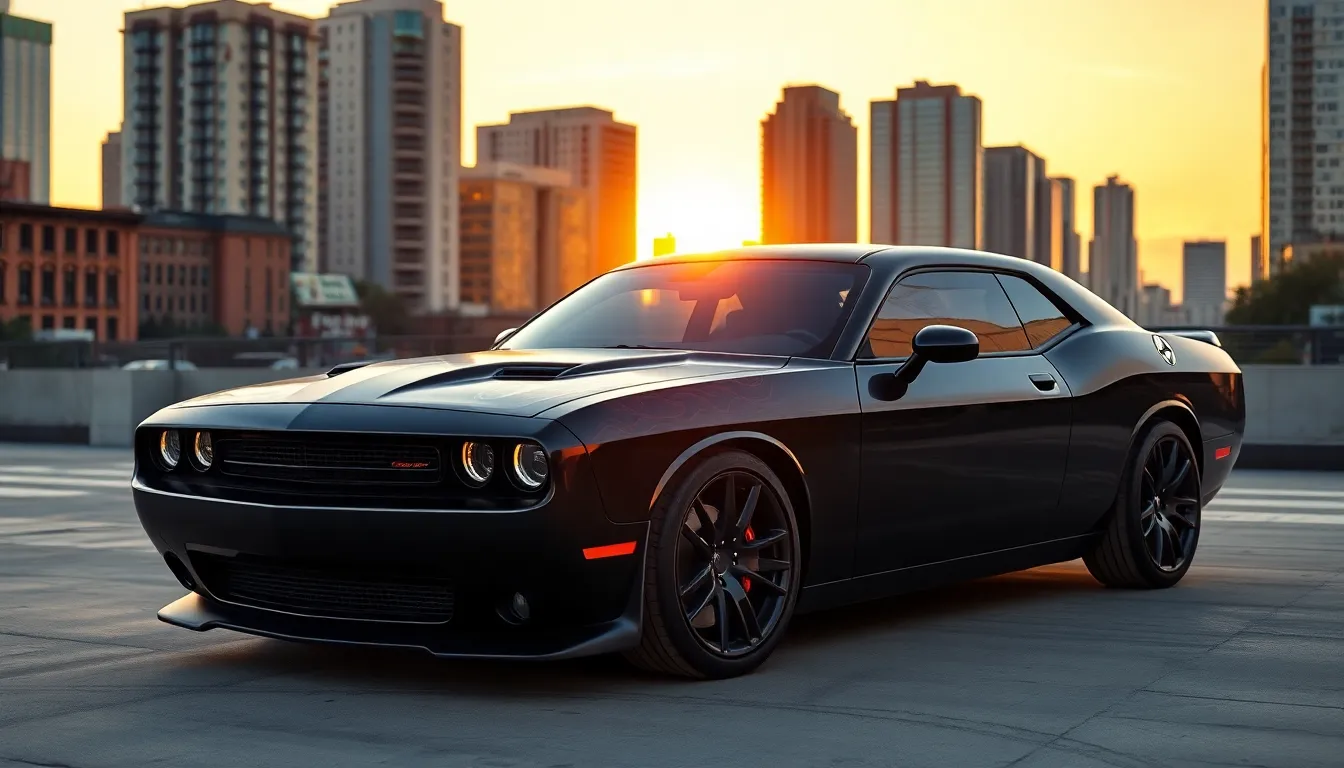
After improving your Challenger’s body and performance, custom paint jobs and graphics provide the perfect finishing touch to create a truly unique muscle car that reflects your personal style.
Matte and Satin Finish Options
Matte black finishes dominate the custom Challenger scene with their aggressive, stealth appearance that eliminates traditional gloss reflections. We recommend brands like 3M and Avery Dennison for their durability and professional-grade adhesion. Satin finishes offer a subtle middle ground between matte and gloss, creating depth while maintaining that custom look enthusiasts crave.
Professional application typically ranges from $3,000 to $6,000 for a complete vehicle wrap, depending on your location and installer experience. DIY vinyl wrap kits cost between $500 to $1,200 but require important skill and patience for proper installation. Matte gray and charcoal options provide sophisticated alternatives to traditional black while maintaining that murdered-out aesthetic.
Maintenance considerations include specialized cleaning products that won’t damage the matte surface texture. Regular car wash soaps can create permanent shine spots on matte finishes, so we always recommend dedicated matte finish cleaners and microfiber cloths.
Racing Stripes and Decal Packages
Classic racing stripes remain the most popular Challenger graphics modification, with dual stripes running from hood to trunk creating that authentic muscle car heritage. We’ve seen excellent results from companies like American Car Create and Mopar Performance Parts, which offer OEM-quality stripe packages ranging from $200 to $800.
Modern interpretations include offset stripes, side body graphics, and custom numbering that references racing history or personal significance. Vinyl stripe widths typically range from 6 to 12 inches, with 10-inch stripes providing the most proportional appearance on the Challenger’s wide body.
Color combinations work best when they contrast sharply with your base paint, such as white stripes on black paint or black stripes on bright colors like Go Mango or Plum Crazy Purple. Reflective and metallic stripe materials add nighttime visibility and unique texture variations under different lighting conditions.
Custom Airbrushed Designs
Professional airbrush artists can transform your Challenger into a rolling work of art with custom designs ranging from subtle flame effects to elaborate murals depicting American themes or personal interests. Quality custom airbrush work typically starts at $2,000 for simple designs and can exceed $10,000 for full-vehicle masterpieces.
Popular design themes include traditional flames in realistic colors, skull and crossbone motifs, patriotic eagle designs, and abstract geometric patterns that complement the Challenger’s angular body lines. We’ve observed increasing demand for custom pin-up artwork and vintage racing imagery that pays homage to muscle car culture.
Preparation requirements involve extensive masking, primer application, and multiple clear coat layers to protect the artwork from UV damage and road debris. Professional artists typically require 2 to 4 weeks for complex designs, depending on detail level and drying time between coats.
Custom Wheel and Tire Combinations for Enhanced Style and Performance
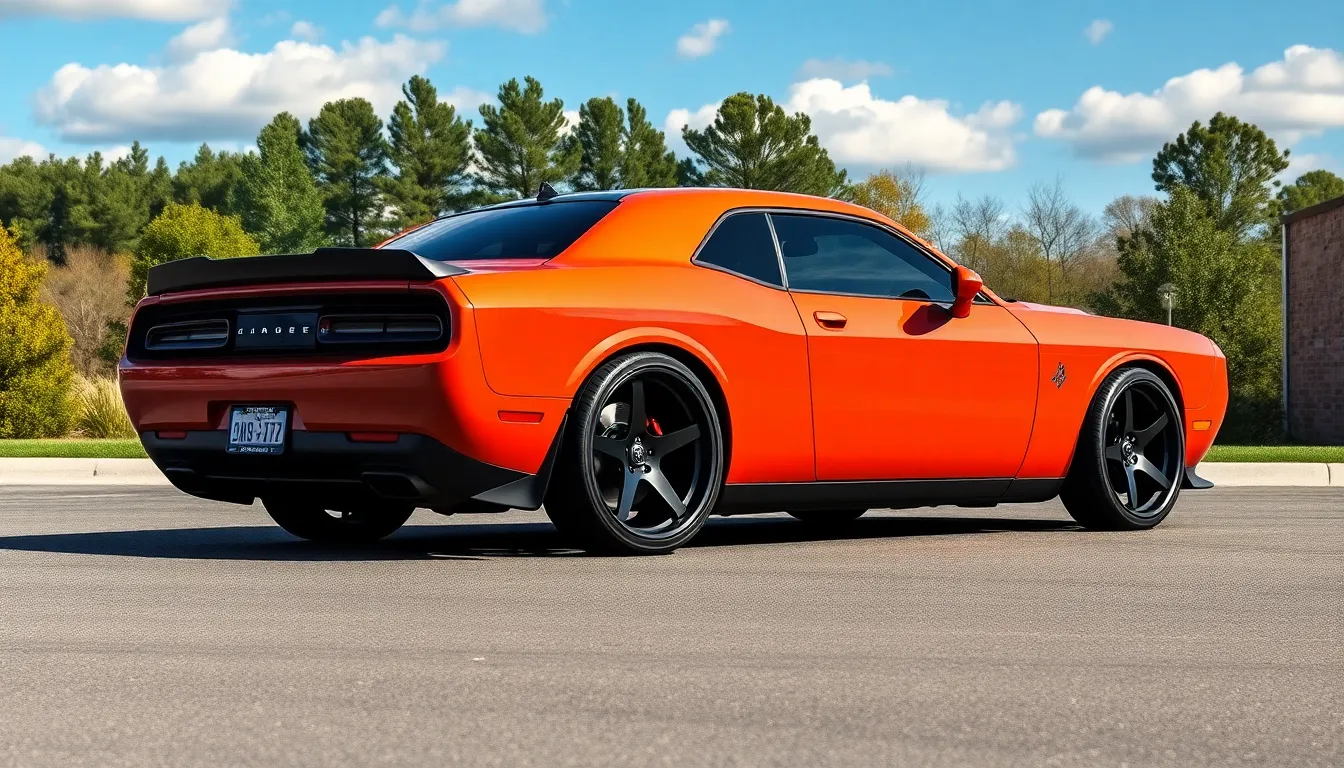
We’ve covered performance upgrades and exterior modifications, but choosing the right wheel and tire combination can transform your Challenger’s appearance while boosting handling capabilities. Proper wheel selection impacts both the aesthetic appeal and driving dynamics of your custom build.
Forged Aluminum and Carbon Fiber Wheels
Forged aluminum wheels offer the perfect balance of strength, weight reduction, and style for Challenger enthusiasts seeking premium upgrades. Popular brands like HRE, Forgeline, and Vossen provide custom fitments specifically designed for Challenger applications, typically ranging from 20 to 22 inches in diameter. These wheels can reduce unsprung weight by 15 to 25 pounds per corner compared to factory options, improving acceleration and braking performance.
Carbon fiber wheels represent the pinnacle of wheel technology, offering even greater weight savings of up to 40% over traditional aluminum wheels. Companies like Carbon Revolution and Forgeline manufacture carbon fiber options for the Challenger, though prices start around $3,000 per wheel. Installation requires careful consideration of load ratings and proper torque specifications to prevent damage.
Aftermarket wheel widths for the Challenger typically range from 9.5 inches up to 12 inches, allowing for aggressive fitments that fill the wheel wells completely. Popular sizes include 20×10 front and 20×11 rear configurations for street applications, while track focused builds often use 18×10 or 18×11 setups for better tire selection.
Low-Profile Performance Tires
Low profile performance tires enhance your Challenger’s handling characteristics while maintaining the aggressive stance that wide body modifications create. Premium tire manufacturers like Michelin, Continental, and Nitto offer high performance options specifically suited for muscle car applications.
Recommended tire sizes for custom Challenger builds include 275/35R20 front and 315/35R20 rear combinations, which provide excellent grip without compromising ride quality. Track oriented setups benefit from even wider options like 295/30R20 front and 345/30R20 rear, though these require careful suspension tuning to prevent rubbing issues.
Summer performance compounds deliver maximum grip in dry conditions, with popular choices including the Michelin Pilot Sport 4S and Continental ExtremeContact Sport. All season performance tires like the Michelin Pilot Sport A/S 3+ provide year round usability while maintaining respectable performance capabilities. Drag racing applications benefit from specialized tires like Mickey Thompson ET Street R compounds for maximum traction off the line.
Stance and Fitment Considerations
Proper stance and fitment require careful measurement of wheel offset, backspacing, and suspension geometry to achieve the desired look without compromising performance. We recommend working with experienced shops that understand Challenger exact requirements for optimal results.
Wheel offset typically ranges from +15mm to +35mm for most custom applications, with wider wheels requiring more aggressive offsets to clear suspension components. Backspacing calculations become critical when running wide body kits or lowered suspension setups to prevent interference with fender wells or suspension arms.
Suspension modifications often accompany custom wheel and tire setups, with lowering springs or coilover systems providing the proper stance while maintaining handling performance. Popular options include Eibach Pro Kit springs for moderate drops or full coilover systems from KW or Bilstein for adjustable height and damping control.
Rolling or pulling fenders may become necessary when running aggressive wheel and tire combinations, particularly with lowered suspension setups. Professional installation ensures proper clearance without damaging the vehicle’s body panels or compromising structural integrity.
Custom Interior Upgrades to Elevate Your Driving Experience

Transforming your Challenger’s interior creates a personalized cockpit that matches your exterior modifications. We’ll explore the essential upgrades that enhance both comfort and performance while maintaining that classic muscle car atmosphere.
Racing Seats and Harness Systems
Racing seats transform your Challenger into a true performance machine by providing superior support during aggressive driving. Recaro, Sparco, and Bride offer bucket seats specifically designed for muscle cars, with prices ranging from $800 to $2,500 per seat. These seats feature deep bolsters, lightweight construction, and mounting hardware that fits directly into your Challenger’s floor pan.
Four-point and five-point harness systems replace factory seatbelts for track day adventures or show car authenticity. Simpson, Schroth, and Sparco manufacture DOT-approved harnesses that integrate seamlessly with racing seats. Installation requires roll cage mounting points or harness bars, which typically cost between $200 and $600 depending on complexity.
Proper seat positioning ensures optimal pedal reach and steering wheel access while maintaining safety standards. Most racing seats sit lower than factory units, improving the car’s center of gravity and providing a more connected driving experience. We recommend professional installation to ensure proper belt angles and structural integrity.
Custom Dashboard and Gauge Clusters
Digital gauge clusters replace factory analog instruments with customizable displays that monitor performance parameters. Dakota Digital and Classic Instruments offer direct-fit answers for Challengers, featuring programmable warning lights, boost pressure readings, and data logging capabilities. These systems range from $1,200 to $3,000 and include plug-and-play wiring harnesses.
Carbon fiber dashboard overlays provide a modern aesthetic while maintaining factory functionality. Manufacturers like American Car Create produce precision-cut pieces that install over existing trim panels without permanent modifications. These overlays cost between $300 and $800 and include 3M automotive-grade adhesive for secure mounting.
Additional gauges monitor critical engine functions that factory instruments don’t display. Oil pressure, coolant temperature, and boost gauges mount in custom A-pillar pods or center console locations. Auto Meter and VDO offer 52mm gauges that match various interior color schemes, with complete setups costing $400 to $1,000.
Premium Sound System Installations
Component speaker systems deliver audiophile-quality sound that complements your Challenger’s powerful engine note. Focal, JL Audio, and Rockford Fosgate manufacture speakers specifically sized for Challenger door panels and rear deck locations. Complete component sets range from $600 to $2,500 and include crossovers, tweeters, and mid-bass drivers.
Custom subwoofer enclosures maximize trunk space while delivering deep bass response. Stealth enclosures fit behind rear seats or integrate into spare tire wells, preserving cargo capacity for daily driving. These systems typically require 500 to 1,000 watts of amplifier power and cost between $800 and $2,000 installed.
Amplifier installations power upgraded speakers without taxing the factory electrical system. Class D amplifiers from Alpine, Pioneer, and Kenwood provide clean power in compact packages that mount under seats or in trunk corners. Professional installation ensures proper wiring, grounding, and integration with factory head units, with total costs ranging from $1,200 to $4,000 for complete premium systems.
Custom Suspension and Handling Modifications for Better Performance
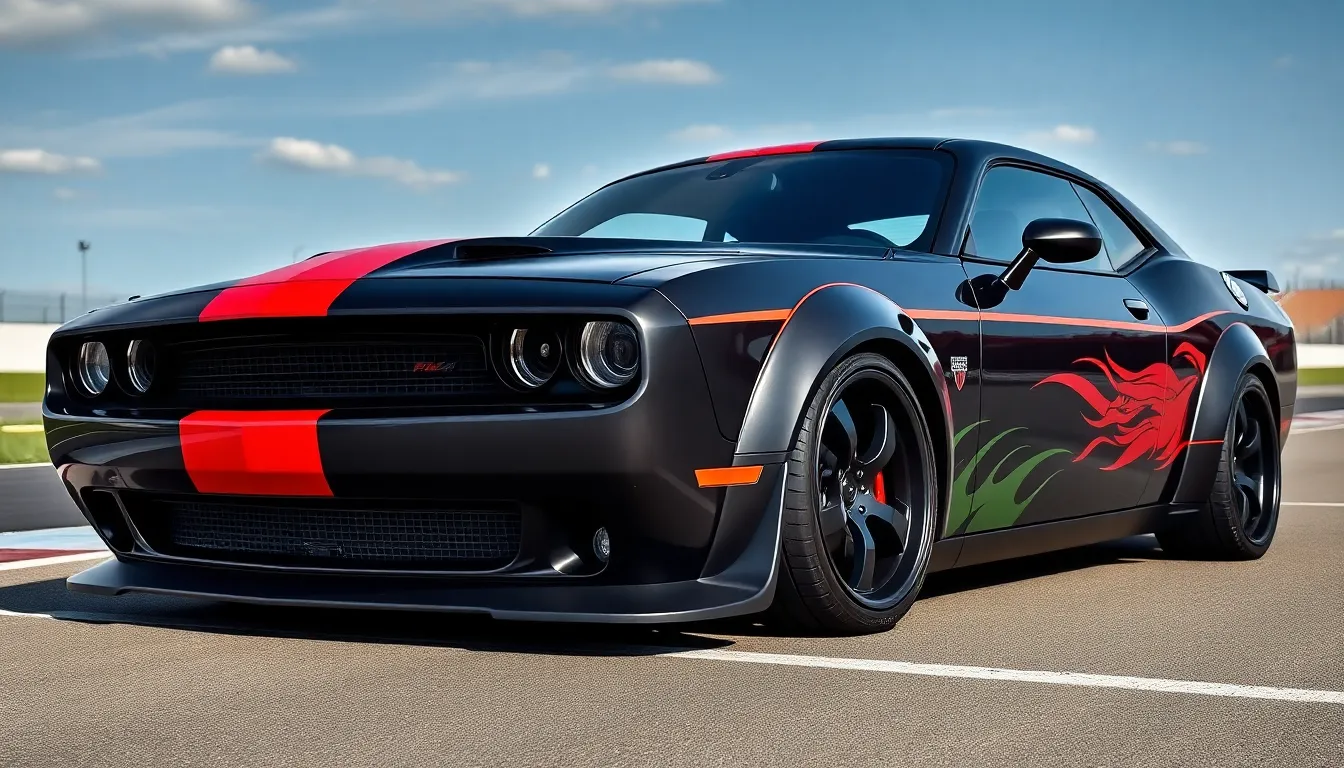
Building on our previous modifications, the suspension system transforms how your Challenger handles corners and maintains stability. We’ll explore three essential upgrades that dramatically improve performance while complementing the engine and exterior modifications we’ve discussed.
Coilover Suspension Systems
Coilover systems provide the most comprehensive suspension upgrade for your custom Challenger, offering adjustable height and damping control. Popular brands like KW Variant 3 and Bilstein PSS10 deliver track-ready performance with street comfort. These systems replace factory struts and springs with a single unit that adjusts ride height from 0.4 to 2.4 inches.
Performance benefits include reduced body roll during cornering and improved weight transfer control during acceleration. We recommend starting with middle damping settings and adjusting based on driving style. Installation typically requires professional alignment and corner balancing for optimal results.
Budget options like BC Racing coilovers offer similar adjustability at $1,200-1,800, while premium setups from Ohlins can reach $3,000-4,500. Height adjustability allows you to achieve the perfect stance while maintaining functionality for daily driving.
Sway Bars and Strut Tower Braces
Sway bars reduce body roll by connecting opposite wheels and transferring load during cornering. Hellion Power Sports and BMR Suspension offer front and rear sway bar kits that dramatically improve handling without sacrificing ride quality. Front bars typically measure 32-35mm diameter while rear bars range from 22-25mm.
Strut tower braces connect the front suspension towers to reduce chassis flex during aggressive driving. These bolt-on modifications cost $150-400 and install in 30-60 minutes. Popular options include adjustable aluminum braces from Steeda and fixed carbon fiber units from Anderson Composites.
Combined installations create a more responsive steering feel and improved cornering stability. We’ve found that pairing larger sway bars with strut tower braces provides the best balance of performance and comfort for modified Challengers.
Adjustable Control Arms
Adjustable control arms correct suspension geometry after lowering your Challenger and provide fine-tuning capabilities for track use. Upper and lower control arm sets from companies like QA1 and Hotchkis allow camber and caster adjustments that improve tire contact patches during cornering.
Front upper control arms typically adjust camber from +3 to -3 degrees, while lower arms provide additional caster adjustment. Rear control arms address camber changes caused by lowered ride height. Professional installation and alignment are essential for proper geometry.
Spherical bearings in performance control arms eliminate compliance for sharper handling response, though they may increase noise and vibration. Polyurethane bushed versions offer a compromise between performance and comfort for street-driven customs. Complete control arm packages range from $800-2,200 depending on materials and adjustability features.
Custom Lighting Modifications for Improved Visibility and Style
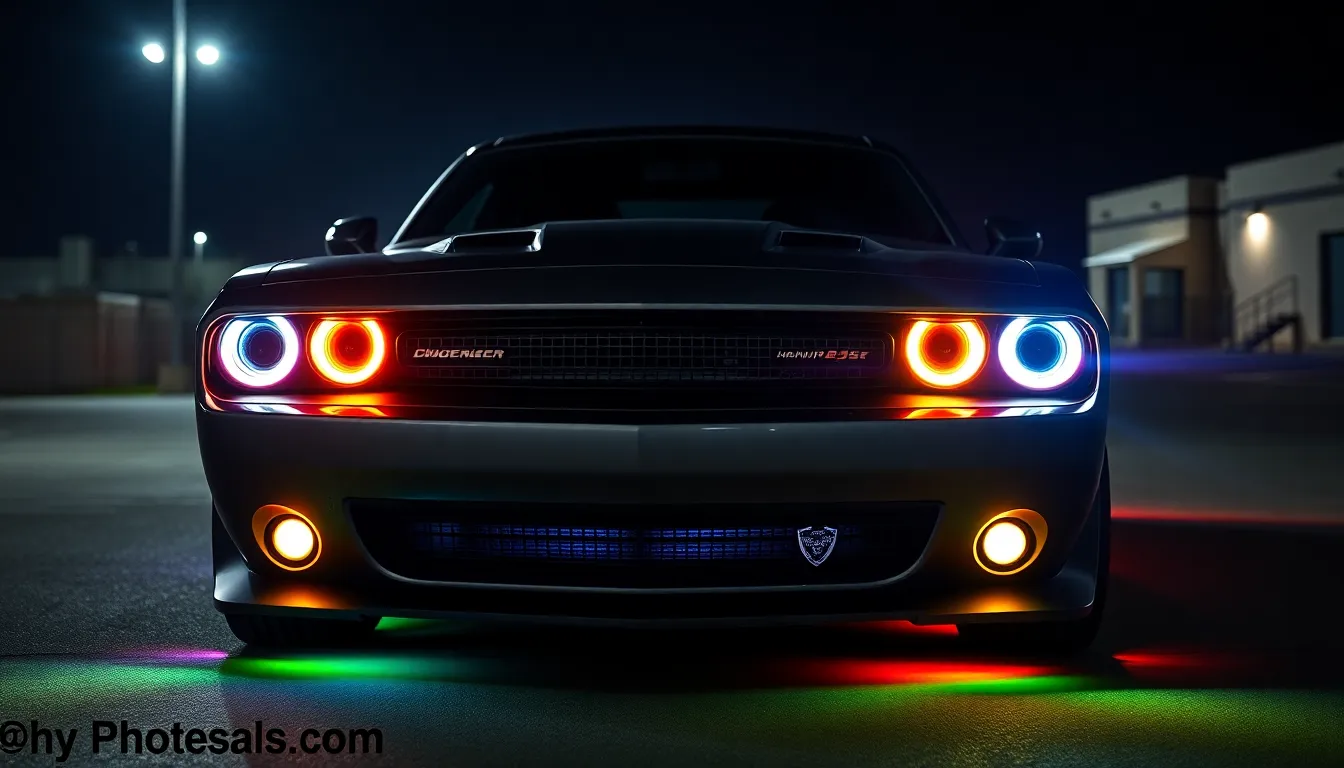
Custom lighting upgrades transform your Dodge Challenger’s appearance while delivering enhanced visibility and safety benefits. These modifications create distinctive nighttime aesthetics that complement the suspension and handling improvements we’ve discussed.
LED Headlight and Taillight Conversions
LED headlight conversions deliver up to 300% brighter illumination compared to factory halogen bulbs while consuming 75% less power. Popular options include complete headlight assemblies with integrated DRL strips and projector beam patterns that eliminate glare for oncoming traffic. Morimoto XB LED headlights offer plug-and-play installation with sequential startup animations and cost between $800-$1,200 per pair.
Taillight conversions feature modern LED arrays that provide faster response times and longer lifespan than traditional bulbs. Aftermarket options like Raxiom Vector taillights incorporate OLED technology with customizable startup sequences and smoked or clear lens options. Installation typically requires basic wiring modifications and professional installation ensures proper beam alignment and DOT compliance.
Complete LED conversion packages for both front and rear lighting systems range from $1,500-$3,500 depending on features and brand selection. Higher-end options include adaptive headlights that adjust beam patterns based on steering input and traffic conditions.
Underglow and Accent Lighting
Underglow lighting systems create dramatic ground effects that highlight your Challenger’s custom stance and wheel modifications. RGB LED strip kits allow color customization through smartphone apps with options for solid colors, breathing effects, and music synchronization. Quality underglow systems like Oracle ColorSHIFT feature waterproof construction and cost $300-$600 for complete four-piece kits.
Interior accent lighting enhances the cabin atmosphere with LED strips installed along door panels, dashboard edges, and footwell areas. These systems integrate with existing interior upgrades like custom gauges and racing seats while providing multiple color options and brightness levels. Professional installation ensures proper wire routing and prevents interference with vehicle electronics.
Accent lighting extends to engine bay illumination using LED strips or spotlights that showcase custom engine modifications during car shows. These systems feature heat-resistant construction and quick-disconnect wiring for maintenance access while adding $200-$400 to your lighting budget.
Custom Sequential Turn Signals
Sequential turn signal conversions create the iconic “sweeping” effect popularized by classic muscle cars and modern performance vehicles. These systems activate LED segments in sequence from inside to outside, providing improved visibility and distinctive styling that complements your Challenger’s custom exterior modifications. Popular brands like Diode Dynamics offer direct-fit sequential modules for $400-$800 per set.
Modern sequential systems integrate with factory wiring harnesses and maintain all safety functions including hazard lights and emergency flashers. Advanced options include variable sweep speeds, reverse sequential patterns, and integration with DRL functions for enhanced daytime visibility.
Custom mirror turn signals with sequential LED arrays provide additional safety benefits during lane changes and turns. These modifications typically cost $200-$400 per pair and feature plug-and-play installation that preserves factory mirror heating and power adjustment functions. Professional installation ensures proper timing synchronization with existing turn signal systems and compliance with local lighting regulations.
Custom Exhaust Systems That Deliver Power and Sound
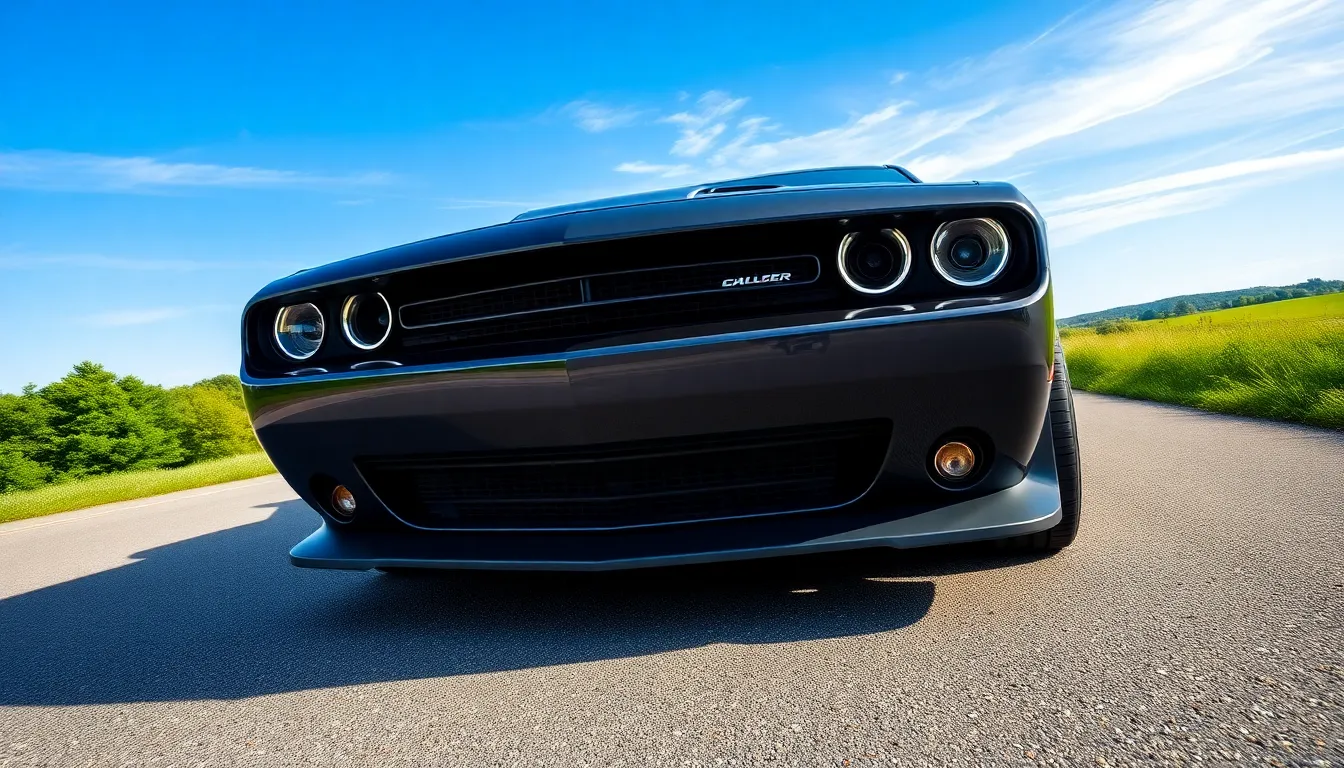
Exhaust modifications represent one of the most impactful upgrades for your Dodge Challenger custom build. We’ll explore how strategic exhaust enhancements can unlock hidden horsepower while delivering that unmistakable muscle car rumble.
Cat-Back Exhaust Modifications
Cat-back systems transform your Challenger’s sound profile while increasing rear wheel horsepower by 15-25. These complete rear exhaust replacements connect from the catalytic converter to the exhaust tips, offering the perfect balance of performance and sound enhancement. Popular manufacturers like Borla ATAK and Corsa Xtreme deliver aggressive tones that complement the Challenger’s muscle car DNA.
Performance gains from quality cat-back systems include improved exhaust flow and reduced backpressure. We’ve seen consistent dyno results showing 20+ horsepower increases on stock R/T models with proper tuning. Stainless steel construction ensures longevity while mandrel-bent piping maintains optimal flow characteristics throughout the system.
Sound customization options range from mild touring tones to track-ready aggressive notes. Systems like the Flowmaster Outlaw deliver deep, rumbling bass tones perfect for weekend cruising, while the MagnaFlow Competition series provides race-inspired sound levels. Installation typically requires 2-3 hours and basic hand tools for most DIY enthusiasts.
Headers and Mid-Pipe Upgrades
Long tube headers provide the most important performance improvements for naturally aspirated Challenger engines. These upgrades replace restrictive factory manifolds with free-flowing designs that can add 25-40 horsepower to your build. American Racing Headers and Kooks Custom Headers offer popular options specifically engineered for various Challenger engine configurations.
Mid-pipe modifications complement header upgrades by maintaining exhaust flow momentum through the system. High-flow catalytic converters or straight-pipe sections (for off-road use) eliminate restriction points that limit performance potential. We recommend pairing these upgrades with professional ECU tuning to maximize power gains and ensure proper air-fuel ratios.
Installation complexity increases with header upgrades due to tight engine bay access requirements. Professional installation typically costs $800-1,200 but ensures proper fitment and leak-free operation. These modifications work exceptionally well with forced induction setups, supporting the increased exhaust volume from supercharged and turbocharged applications.
Active Exhaust Valve Systems
Electronic valve systems offer on-demand sound control for your custom Challenger exhaust setup. These sophisticated systems use motorized valves to alter exhaust routing, providing quiet operation for daily driving and aggressive sound for performance applications. Companies like Varex and QTP manufacture reliable valve systems compatible with most aftermarket exhaust configurations.
Remote control operation allows instant exhaust character changes from inside the cabin. We’ve installed systems that integrate with existing key fobs or smartphone apps, giving you complete control over your Challenger’s exhaust personality. Quiet mode reduces sound output by 50-70% for neighborhood-friendly operation, while sport mode delivers full aggressive tones.
Integration with factory electronics maintains OEM functionality while adding custom features. Advanced systems can automatically adjust valve position based on driving modes, RPM thresholds, or time-based settings. Installation requires basic wiring skills and typically takes 3-4 hours when combined with cat-back system upgrades, making it an excellent addition to comprehensive Challenger custom builds.
Popular Custom Challenger Build Themes and Styles

Custom Challenger enthusiasts typically follow distinct build philosophies that shape their modification choices. Understanding these popular themes helps us identify the right direction for our own builds.
Modern Muscle Car Builds
Modern muscle car builds focus on blending contemporary technology with classic Challenger aesthetics. We see these builds featuring wide body kits like the Liberty Walk conversion paired with aggressive carbon fiber splitters and rear diffusers. Suspension systems typically include air ride setups that allow for dramatic stance adjustments while maintaining drivability.
Engine modifications in modern builds commonly incorporate forced induction systems with supercharger conversions producing 700+ horsepower. Interior upgrades emphasize technology integration with custom touchscreen displays and premium leather seating with modern stitching patterns. Wheel selections often feature massive 22-inch forged wheels in concave designs with low profile performance tires.
Color schemes frequently use vibrant pearl finishes like Ocean Blue Pearl or custom two-tone combinations that weren’t available from the factory. LED lighting packages replace traditional halogen systems throughout the vehicle including sequential taillights and underglow accent lighting.
Retro Classic Restoration Styles
Retro classic builds pay homage to the original 1970s Challenger era with period-correct modifications and styling cues. Factory color matching takes priority with authentic options like Plum Crazy Purple, Go Mango Orange, and In-Violet being popular choices among enthusiasts.
Wheel selections stick to classic American racing designs like Torq Thrust or Rallye wheels in traditional 15-17 inch diameters. Engine bay modifications emphasize visual authenticity with chrome valve covers, air cleaners, and vintage-style headers that maintain the classic muscle car appearance.
Interior restorations focus on period-appropriate materials including vinyl bench seats and classic gauge cluster designs. Sound systems integrate vintage-looking components that hide modern functionality behind classic aesthetics. Suspension modifications remain subtle with performance improvements that don’t compromise the original ride quality or stance.
Stripe packages follow traditional racing stripe patterns in contrasting colors that complement the base paint. Hood modifications typically include functional scoops like the classic shaker hood or Six Pack designs that enhance the retro appearance.
Track-Ready Performance Builds
Track-ready builds prioritize maximum performance with weight reduction and aerodynamic enhancements taking precedence over comfort features. Roll cage installations become essential safety modifications along with racing seats and multi-point harness systems for driver protection.
Suspension systems use coilover setups with adjustable compression and rebound settings for fine-tuning handling characteristics. Wheel packages typically feature lightweight forged aluminum options in 18-19 inch diameters paired with sticky R-compound tires for maximum grip.
Engine modifications focus on reliable high horsepower output with built internals supporting forced induction systems. Cooling system upgrades include larger radiators, oil coolers, and transmission coolers to handle extended track sessions. Brake upgrades feature 6-piston calipers with vented rotors and high-temperature brake fluid for consistent stopping power.
Aerodynamic packages include functional front splitters, rear wings, and side skirts that generate downforce at speed. Interior modifications strip unnecessary weight while adding essential gauges for monitoring engine vitals during performance driving. Fire suppression systems and quick-release steering wheels complete the safety equipment roster for serious track use.
Conclusion
The Dodge Challenger’s customization potential is truly limitless. Whether you’re drawn to subtle enhancements or radical transformations the platform offers something for every enthusiast and budget level.
We’ve explored comprehensive modification paths from engine upgrades and suspension tuning to custom paint schemes and interior refinements. Each category provides opportunities to create a truly personal expression while maintaining the Challenger’s iconic muscle car identity.
The key to successful customization lies in choosing modifications that align with your driving goals and aesthetic vision. Start with priority upgrades that deliver the most impact then build systematically toward your dream configuration.
Your custom Challenger journey represents more than just modifications—it’s about joining a community of passionate enthusiasts who appreciate American muscle car heritage while pushing performance boundaries.
Frequently Asked Questions
What makes the Dodge Challenger a popular choice for custom builds?
The Dodge Challenger remains popular for custom builds because it embodies the quintessential American muscle car spirit. Its iconic design provides an excellent foundation for modifications, allowing enthusiasts to enhance both performance and aesthetics while preserving its classic heritage. The car’s robust platform can accommodate various customization levels, from minor enhancements to complete overhauls.
What are the most effective engine modifications for increasing Challenger performance?
The most effective engine modifications include supercharger and turbocharger installations, which can significantly boost horsepower and torque. Hellcat-style supercharger conversions are popular for R/T models, while various turbocharger systems work well for both V6 and V8 engines. Cold air intakes, performance exhaust systems, and ECU tuning further optimize performance and increase horsepower output.
What exterior body modifications are available for the Challenger?
Popular exterior modifications include wide body kits like Hellcat-style conversions for a more aggressive stance, custom front and rear spoilers for improved aerodynamics, and hood scoops or vented hoods for better engine cooling. Fender flares offer a budget-friendly option to enhance the car’s appearance while accommodating larger wheels and tires.
How do custom paint jobs and graphics enhance a Challenger’s appearance?
Custom paint jobs and graphics allow owners to create unique vehicles that reflect personal style. Popular finishes include matte and satin options, racing stripes, and decal packages that enhance the classic look. Custom airbrushed designs offer artistic possibilities, transforming the Challenger into a rolling work of art while maintaining its muscle car DNA.
What wheel and tire combinations work best for custom Challengers?
The best combinations include forged aluminum or carbon fiber wheels that reduce weight and improve handling. Popular aftermarket options accommodate various sizes, paired with low-profile performance tires for enhanced grip. Proper stance and fitment considerations are crucial, often requiring precise measurements and potential suspension modifications for optimal results.
What interior upgrades can enhance the Challenger’s driving experience?
Key interior upgrades include racing seats and harness systems for superior support during aggressive driving, custom dashboard and gauge clusters for improved functionality, and premium sound system installations with component speakers and subwoofers. These modifications elevate comfort, safety, and entertainment while maintaining the muscle car aesthetic.
How do suspension upgrades improve Challenger performance?
Suspension upgrades like coilover systems provide adjustable height and damping control for enhanced handling. Sway bars and strut tower braces reduce body roll and improve chassis stability, while adjustable control arms allow fine-tuning of suspension geometry. These modifications create a more responsive and stable driving experience for both street and track use.
What custom lighting options are available for the Challenger?
Custom lighting options include LED headlight and taillight conversions for brighter illumination and modern aesthetics, underglow and accent lighting systems for dramatic effects, and custom sequential turn signals for improved visibility. Professional installation is recommended to ensure safety compliance and proper functionality of these lighting upgrades.
How do custom exhaust systems affect Challenger performance and sound?
Custom exhaust systems can increase rear wheel horsepower by 15-25 through cat-back modifications, while header and mid-pipe upgrades can add 25-40 horsepower. Popular manufacturers like Borla ATAK and Corsa Xtreme offer aggressive sound profiles. Active exhaust valve systems provide on-demand sound control for a customizable auditory experience.
What are the main custom Challenger build themes?
The three main build themes are Modern Muscle Car Builds that blend contemporary technology with classic aesthetics, Retro Classic Restoration Styles that honor the original 1970s design, and Track-Ready Performance Builds that prioritize maximum performance and safety. Each theme offers specific modification packages, color schemes, and interior upgrades reflecting different enthusiast philosophies.

